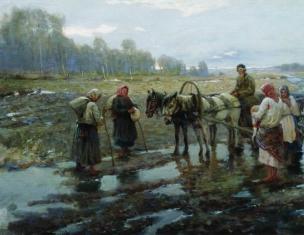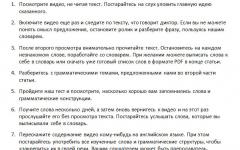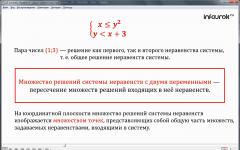Plan
1. Denaturation and coagulation of proteins: physical and chemical essence.
2. Destruction of proteins: physical and chemical essence.
3. The effect of changes in proteins on their nutritional value.
4. The problem of protein deficiency and ways to solve it.
1. Denaturation and coagulation of proteins: physical and chemical essence
Denaturation– disruption of the spatial structure of a protein molecule under the influence external factors, most often heating, which leads to changes in the natural properties of the protein. From a physical point of view, denaturation is considered as disordering of the conformation of a polypeptide chain without changing primary structure. Denaturation can be thermal (as a result of heating), surface (by shaking, beating), acidic or alkaline (as a result of exposure to acids and alkalis). Thermal denaturation accompanies the change food products in almost all processes of culinary processing of protein-containing products.
Mechanism of thermal denaturation: at room temperature a certain spatial arrangement of the protein globule is maintained due to cross-links between sections of the polypeptide chain: hydrogen, disulfide (-S-S-). These bonds are not strong, but have sufficient energy to keep the polypeptide chain in a folded state. When proteins are heated, the thermal movement of atoms and polypeptide chains of protein molecules increases, as a result of which cross-links are destroyed and hydrophobic interactions between side chains are weakened. As a result, the polypeptide chain unfolds important role In this case, water plays a role: it penetrates into parts of the protein molecule and promotes the unfolding of the chain. Completely anhydrous proteins isolated in crystalline form are very stable and do not denature even when heated for a long time to temperatures of 100ºC or higher. The unfolding of the protein globule is accompanied by the formation of new cross-links, with disulfide bonds becoming especially active.
Denaturation of globular proteins occurs through the unfolding of a protein globule and its subsequent folding in a new type. Strong covalent bonds are not destroyed during such a rearrangement.
Denaturation of fibrillar proteins(for example, collagen in the connective tissue of meat): the bonds holding the spatial structure in the form of a spiral are broken and the protein thread contracts; with prolonged heat treatment, the collagen fibers turn into a glassy mass.
Denaturation is accompanied by a change in the most important properties of the protein: loss of biological activity (inactivation of enzymes), species specificity (change in color, for example, meat), ability to hydrate (when the conformation changes, hydrophobic groups appear on the surface of the protein globule, and hydrophilic ones are blocked as a result of the formation of intramolecular bonds ), improving attackability by proteolytic enzymes, increasing reactivity proteins, aggregation of protein molecules. A
Aggregation– interaction of denatured protein molecules with the formation of larger particles. Externally, this is expressed in different ways: in low-concentrated protein solutions - the formation of foam (flakes on the surface of the broth), in more concentrated protein solutions - the formation of a continuous gel with their simultaneous compaction and separation of liquid into environment(dehydration). This is how proteins in meat, fish, and eggs are denatured. The amount of dehydration depends on the acidity of the medium - when acidifying, less moisture is lost, so when marinating poultry and fish, the products are more juicy.
In an undenatured state, proteins are a sol (solution); as a result of denaturation, the solution transforms into a jelly (gel). If the protein is in a highly concentrated state, then during the cooking process a continuous jelly is formed, which covers the entire volume of the system (for example, egg white).
Coagulation– the transition of a sol to a gel, that is, from one colloidal state to another. It is impossible to put an equal sign between the processes of denaturation and coagulation, although in most processes coagulation accompanies denaturation, but sometimes not. For example, when milk is boiled, lactoalbumin and lactoglobulin are denatured and coagulated, while casein does not change its colloidal state.
Each protein has a certain denaturation temperature. For example, for fish proteins, the lowest temperature level of denaturation at which visible denaturation changes begin is about 30ºC, for egg white – 55ºC.
Changing the pH of the medium affects the denaturation temperature: at pH values close to ITB, denaturation occurs at a lower temperature and is accompanied by maximum protein dehydration. Creating an acidic environment during heat treatment helps reduce dehydration and the product is more juicy.
The denaturation temperature increases in the presence of other more thermostable proteins and some non-protein substances, for example, sucrose.
2. Destruction of proteins: physical and chemical essence
In the manufacture of culinary products, changes in proteins are not limited to denaturation: to bring products to a state of culinary readiness, heating is carried out at a temperature of 100ºC and above, while further changes in proteins occur, accompanied by the destruction of the protein macromolecule.
Destruction– further post-denaturation changes in proteins, occurring at temperatures of 100ºC and above and accompanied at the first stage by the destruction of protein macromolecules with the separation of volatile compounds (ammonia, hydrogen sulfide, hydrogen phosphorous, etc.) involved in the formation of the aroma of the finished product. During prolonged heat treatment, depolymerization occurs (destruction of the protein chain) with the formation of water-soluble nitrogenous substances.
A striking example of the destruction of denatured protein is the transition of collagen to glutin during the cooking of broths and jellies. Protein destruction occurs in the production of certain types of dough. In this case, the destruction of intramolecular bonds in proteins occurs with the participation of proteolytic enzymes contained in flour and produced by yeast cells.
Destruction of proteins can be a purposeful method of culinary processing that contributes to the intensification of the technological process (the use of enzyme preparations to soften meat, weaken the gluten of dough, obtain protein hydrolysates, etc.)
Protein hydrolysis– cleavage of the polypeptide chains of a protein molecule with the release of amino acids. This reaction occurs under the action of enzymes in the gastrointestinal tract.
Protein hydration accompanies everything technological processes and improves protein digestibility. Denaturation, depending on the depth, affects digestibility in different ways: with light denaturation, protein digestibility improves (soft-boiled egg), and with further compaction (hard-boiled egg), digestibility worsens. For maintenance essential amino acids neither denaturation nor coagulation has any effect.
The decrease in nutritional value is associated with very long heating: when cooking for 2 hours, 5.2% of essential amino acids are destroyed. Reheating products above 100ºC has a particularly strong effect on the biological value.
The coagulation system consists of enzymes coagulation, non-enzymatic protein cofactors And inhibitors coagulation. The purpose of this system is the formation of the enzyme thrombin, which is responsible for the conversion of fibrinogen into fibrin.
Clotting factors
1. Enzymes, are serine proteases (except factor XIII):
- factor II - prothrombin,
- factor VII – proconvertin,
- factor IX – antihemophilic globulin B or Christmas factor,
- factor X – Stewart-Prower factor,
- factor XI – antihemophilic globulin C or Rosenthal factor,
- factor XIII – fibrin-stabilizing factor or Lucky-Lorand factor.
2. Cofactor proteins, which do not have proteolytic activity. The role of these proteins is to bind and secure enzymatic factors on the platelet membrane:
- factor V – proaccelerin, is a cofactor of factor Xa,
- factor VIII – antihemophilic globulin A, is a cofactor of factor IXa,
- von Willebrand factor.
- high molecular weight kininogen (HMK, Fitzgerald-Fluger factor) – cofactor f.XII and prekallikrein receptor. It must be borne in mind that according to the new cellular theory, these proteins belong to the fibrinolysis system.
3. Structural protein of thrombus formation - factor I ( fibrinogen).
Thrombin (factor II)
Thrombin, a key enzyme in hemostasis, is serine protease. In the liver, with the participation of vitamin K, the synthesis of its inactive precursor occurs - prothrombin, which subsequently circulates in the plasma. In blood plasma, the conversion of prothrombin to thrombin occurs directly under the influence of factor Xa (together with Va).
Functions of thrombin in hemostasis
In the zone coagulation:
- conversion of fibrinogen into fibrin-monomers,
- activation fibrin-stabilizing factor(form XIII, transglutaminase),
- acceleration of coagulation through activation of factors V, VIII, IX, XI ( positive feedback),
- activation platelets(secretion of granules),
- in combination with thrombomodulin(in high concentrations) activates TAFI (thrombin activatetable fibrinolysis inhibitor),
- activation of smooth muscle cells,
- stimulation of leukocyte chemotaxis,
Out of zone coagulation
- in combination with thrombomodulin activates protein C,
- stimulates secretion from endothelial cells prostacyclin And t-PA.
Fibrinogen (factor I)
Fibrinogen(factor I) is a large multicomponent protein that consists of three pairs of polypeptide chains - Aα, Bβ, γγ, interconnected by disulfide bridges. Spatial structure fibrinogen molecules have a central E-domain and 2 peripheral D-domains, the α- and β-chains at the N-terminus have globular structures - fibrinopeptides A and B(FP-A and FP-B), which close the complementary sites in fibrinogen and do not allow this molecule to polymerize.
The structure of fibrinogen
Fibrinogen synthesis does not depend on vitamin K and occurs in the liver and in RPE cells. Some fibrinogen is synthesized in megakaryocytes and platelets. The conversion of fibrinogen to fibrin occurs under the influence of thrombin.
Fibrin stabilizing factor
Fibrin stabilizing factor(factor XIII) belongs to the transglutaminase enzyme family. It is synthesized in the liver and in platelets; in the blood plasma, most of the inactive factor XIII is associated with fibrinogen. Factor XIII is activated by thrombin limited proteolysis from an inactive predecessor.
Like most other enzymes, factor XIII performs several functions in hemostasis:
- stabilizes fibrin clot through education covalent bonds between the γ-chains of fibrin monomers,
- attaches fibrin clot to fibronectin extracellular matrix,
- participates in binding α2-antiplasmin with fibrin, which helps prevent premature lysis of the fibrin clot,
- required by platelets for the polymerization of actin, myosin and other cytoskeletal proteins used in retraction fibrin clot.
To achieve this goal, blood and formed elements are subjected to heat - coagulation.
During the heating process, the properties of proteins contained in blood and blood products change. The most characteristic and basic changes during heating are thermal denaturation of soluble protein substances. During the process of denaturation, a change in the structure of the protein molecule occurs, which leads to noticeable changes in properties without compromising the composition. Globular proteins unfold folded polypeptide chains that form globule molecules. Restructuring of the structure occurs as a result of the breaking of some intramolecular bonds in the protein molecule upon heating.
Denatured protein differs from natural protein in many properties and characteristics. The temperature at which denaturation occurs varies for different proteins, but is constant for a particular protein. Thus, blood albumin denatures at a temperature of 67 °C, globulins - 69-75, fibrinogen - 56, hemoglobin - about 70 °C. Thus, the main denaturation changes in blood proteins are completed at a temperature of about 70 °C. Neutral salts alkali metals, such as table salt, increase the resistance of proteins to thermal denaturation. Sugars and anions of fatty acids containing 7-12 carbon atoms also have high protective effects. The ability of such substances to increase the resistance of proteins to denaturation can be used when concentrating blood and its plasma by evaporation at higher temperatures.
TO characteristic features the process of protein denaturation includes loss of protein solubility in water, loss biological properties biologically active proteins, in particular enzymes, better digestibility under the influence of gastrointestinal enzymes, loss of the ability to crystallize.
As a result of denaturation, chaotic bonds may arise between polypeptide chains both within the molecule and between molecules of different proteins. The consequence of such changes is the loss of hydrophilicity by proteins, their aggregation and coagulation occur. This creates an insoluble clot. Further heating of the coagulum is accompanied by its compaction with the release of part of the liquid. Coagulation of blood proteins during heat treatment always occurs and accelerates with increasing temperature.
Under conditions of dry heating (without water) of proteins at high temperatures, a pyrogenic process occurs, which leads to the production of dark-colored decomposition products. As a result of these changes, a crust forms on the surface of the equipment, which impairs heat and mass transfer between the coolant (steam) and the processed raw material. Therefore, the duration of the process increases and additional heat and electricity are consumed.
Pyrogenic breakdown of proteins can be avoided by briefly drying the coagulum or blood at high temperatures. To improve heat and mass transfer in periodic dryers, they are not loaded with blood or blood products. large number bones, which during the processing process removes the crust of raw materials from the inner surface of the apparatus.
Heat treatment of blood and blood products is also accompanied by loss of water-soluble vitamins. Vitamins C, D, B, nicotinic and pantothenic acids have the least resistance.
It has been established that during cooking, the loss of thiamine (vitamin B 1) is 50%, and riboflavin (vitamin B 2) is 35%.
To coagulate blood to complete protein coagulation, it is sufficient to heat it to a temperature of 80 °C. In practice, the temperature is brought to 80-90 °C. In this case, a significant number of microorganisms contained in the blood die. The coagulation process is considered complete if the blood acquires a uniform brown or brownish-red color.
Protein coagulation can be carried out using hot or dead steam. More often, live steam is used, for which they use open-type metal containers, to which a steam line is connected, ending in a perforated coil. With this method, the coagulum is unloaded manually.
Coagulation in transfer tanks makes it possible to combine coagulation, transportation and partial separation of moisture in one apparatus. The process is carried out as follows. After loading the blood into the tank, live steam is introduced into it (through the lower coil) until a stream of steam begins to emerge from the exhaust pipe (after about 15 minutes). At the end of coagulation, the access of steam is stopped and the mass is allowed to settle for 5 minutes, after which a sample of the settled liquid is taken. If she has brown and does not become cloudy when heated to a temperature of 100 ° C, this means that the settling process is complete. Otherwise, leave the mass in the transfer tank for another 10-15 minutes. The settled liquid is drained through the drain pipe at the bottom of the apparatus and, having closed the exhaust pipe, steam is released into the transfer tank through the steam line located in its upper part. In this case, the coagulated blood is blown through a pipeline into a vacuum boiler or dryer for 2-3 minutes.
When coagulating blood with dead steam, the heating process proceeds unevenly and for a long time, and a layer of coagulated proteins is formed on the heating surface, which impairs heat transfer and makes it difficult to clean the heating surface.
More efficient coagulation is achieved when using continuous coagulators of screw and injection types.
A continuous screw-type coagulator is an externally insulated single-walled metal vessel with a spherical bottom. An auger is installed in it. The coagulator is equipped with a tightly closing lid with a loading hatch (neck diameter 200 mm) and a periodically opening feeder, which ensures a uniform forced blood supply to the working part of the device and prevents steam loss into the atmosphere. Rotation is transmitted to the auger through a sprocket. The feeder is driven from the auger shaft (rotation speed 0.2 s -1) through a drive sprocket, chain transmission and sprocket.
At the end of the coagulator near the loading hatch there is a steam valve and a perforated pipe through which steam is introduced into the apparatus at a pressure of at least 0.2 MPa. The unloading hatch is located at the opposite end of the apparatus.
Blood coagulation is carried out as follows. Whole blood (with clots) from the collection tank enters the apparatus by gravity through a blood pipeline with a diameter of 38-50 mm, encountering a current of live steam, and is heated to a temperature of 90-95 ° C for 15 s. With the simultaneous supply of steam and blood, conditions are created for their in-line advancement and intensive mixing, which eliminates overheating and prevents the formation of large lumps. The auger moves the coagulum to the opposite end of the apparatus, where it is unloaded through a hatch with a diameter of 360 mm. At a screw rotation speed of 0.1 s -1, the coagulum is unloaded 1.5 minutes after blood enters the apparatus. The coagulator screw squeezes out part of the liquid containing 0.3% protein. The productivity of the coagulator for whole blood is 120 kg/h. It can be adjusted using a plug valve installed on the blood line in front of the loading hatch. After 3-4 hours of operation, the device is cleaned of blood adhering to the screw. To do this, open the lid of the device and use a hose to rinse the auger and the rotating hot water feeder.
The injection-type coagulator from Alfa Laval (Sweden) is a cylindrical tank, inside of which there is a mixer equipped with a steam nozzle and a louvered chamber. The blood entering through the pipe is intensively broken into thin streams of steam. It coagulates, passes through a throttling valve and through a pipe enters the discharge pipe, which directs it for further processing. The presence of a throttle in the coagulator, controlled by a flywheel, allows you to set the required throughput of the installation, the degree of mixing of the mass (blood and steam), as well as the pressure in the discharge pipe. The advantage of this design is the ability to regulate the blood coagulation process. However, it is possible for blood to stick to the throttling valve when turning the steam-blood stream from the mixer to the discharge pipe.
At the Ulan-Ude meat-packing plant, a blood coagulation plant has been developed and is in operation, which consists of a rectangular metal body with a spherical bottom and a screw for mixing blood during coagulation and unloading of the coagulate. A loading hatch with a periodically opening feeder is built into the housing cover, ensuring a uniform supply of blood and preventing steam loss into the atmosphere. On both sides of the housing there are three fittings for supplying steam under a pressure of 0.2-0.3 MPa. There is an unloading hatch at the bottom of the opposite end of the coagulator. To prevent blood leakage, the coagulator is installed with a slope towards the feeder. The auger is driven into rotation by an electric motor through a gearbox and chain transmission. The rotation of the feeder shaft is carried out from the auger shaft through the sprockets of the chain drive. All rotating parts of the coagulator must be guarded.
Blood coagulation is carried out as follows. Flowing by gravity through the feeder into the coagulator and encountering a stream of live steam, the blood is heated to a temperature of 90-95 ° C, coagulated, mixed by a screw and moved to the unloading hatch.
The use of a device of the described design ensures continuity of the process, more complete and uniform blood coagulation.
The actual steam consumption for the coagulation process is 12-13 kg per 100 kg of blood. The yield of coagulum with a moisture content of 80% when coagulating whole blood is 80%, and when coagulating fibrin - 75% of the original raw material. The moisture content in the coagulate depends on the coagulation method, but remains quite high - 86-87.5% when using live steam and 76-81% when coagulating with dead steam.
Preliminary removal of moisture from the coagulum before drying it is important, as it allows to reduce heat consumption.
For dehydration of blood coagulum, settling centrifuges turned out to be the most effective, the principle of their action is as follows. Solid particles of the loaded mass, having a higher density than the liquid phase, are deposited under the action of centrifugal force on the side walls of the rotor, forming in the form of an annular layer closer to the axis of rotation. In continuous centrifuges, loading of the coagulate, as well as removal of the separated components, occurs during operation.
Continuous screw centrifuges of the settling type are most widely used for dehydrating blood coagulum.
The OGSh-321K-01 continuous centrifuge consists of a frame, a rotor, inside which is placed a screw with a planetary gearbox, which receives rotation directly from the rotor (the latter’s axles are located in two supports). The main unit of the centrifuge is a cylindrical rotor located horizontally on two bearing supports (right and left). The rotor is closed at the end with axle-covers, with which it rests on bearings.
The rotor is driven by an electric motor using a V-belt transmission protected by a casing. Inside the rotor there is a screw, which is designed to transport the coagulum to the discharge windows of the rotor. Rotation is transmitted through a special planetary gearbox, which ensures that the auger rotates in the same direction as the rotor, but with some lag. The presence of a difference in the rotation speed of the screw and rotor creates conditions for forced movement of sediment along the inner surface of the rotor. A supply pipe passes through the hollow journals of the rotor and auger, through which coagulated blood is supplied to the internal cavity of the auger drum, from where it is thrown through the windows into the internal cavity of the rotor.
The assembled rotor consists of three main parts: left and right axles and a hollow cylindrical drum. It rotates on two support bearings. The rotor axles simultaneously serve as bottoms that cover the drum from the end. On the end surface of the right axle there are drain windows, which are covered with drain half-disks. The separated water is drained through these holes. On the end surface of the left rotor journal there are windows for unloading the pressed coagulate.
The screw is one of the main components of the centrifuge. It is designed for transporting coagulum and consists of a hollow cylindrical drum, on the outer surface of which spiral turns are welded. Inside the hollow drum, partitions are made, forming three chambers for receiving the mass. The cells have eight unloading windows. Trunnions are attached to the ends of the auger drum, forming the auger support journals. The left auger axle is equipped with splines that are connected to the carrier of the second stage of the planetary gearbox. The auger rests with its axles on bearings mounted in the rotor axles. A radial ball bearing is mounted in the right axle of the rotor, which absorbs axial loads from the auger that arise when the auger transports the pressed coagulate to the unloading windows.
The planetary gearbox is designed to transmit rotor rotation to the auger. The gearbox consists of a cast cylinder, to which covers are bolted at the ends. The right cover is attached to a flange mounted on the left rotor journal. Rubber cuffs are installed in the gearbox cover on the rotor side to prevent oil leakage from the gearbox and dust and dirt from entering it.
Two gear rims with internal gearing of the first and second stages of the gearbox are mounted in the gearbox housing. They are mounted on bearings. In the carrier of the first stage there are two, and in the carrier of the second stage there are three satellites, which are engaged simultaneously with the rims and central gears.
The casing serves as protection against foreign objects getting into the rotating parts of the rotor. In addition, it prevents the penetration of the liquid fraction into the chamber of the pressed product. The inner part of the casing has left and right chambers. The pressed solid fraction (coagulum) enters the left chamber, and the liquid fraction (water) enters the right chamber.
The centrifuge rotor is supported by axles on two supports, each of which consists of a housing, a cover, two side covers and a radial ball bearing. The gearbox protection mechanism protects the gearbox and centrifuge screw from overload and damage. A spring is installed in the housing of the protection mechanism, which absorbs the forces during operation of the centrifuge.
In the event of an instantaneous significant overload or jamming of the auger, the lever tilts the cam lever, and the plate attached to the latter presses the microswitch button, which is installed on the body of the protection mechanism and interlocked with the centrifuge electric motor. At the same time, the electric motor turns off and turns on beep. The planetary gearbox is protected by a casing.
The process of dehydration of coagulated blood in a centrifuge proceeds as follows. Coagulated blood with a temperature of 80-90 °C through the supply pipe enters under a pressure of 9.5-14.2 kPa into the internal cavity of the conical drum, where under the influence centrifugal forces the solid fraction of the coagulum is separated from the liquid (water). The coagulate is deposited on the walls of the rotating rotor, and then transported by a screw to the discharge windows; in the dehydration zone, moisture is removed from the coagulate. Liquid at a temperature of 70-72 °C rushes towards the wide side of the rotor and through the drain windows in the right axle is thrown into the receiving compartment of the casing, from where it falls down under the influence of its own mass. The process of separating the solid fraction from the liquid, unloading the coagulum and draining the centrate occurs continuously. The duration of passage of the coagulated mass and separation into fractions through the centrifuge rotor is 15 s. When pumping coagulated blood into the centrifuge, the excess pressure should not exceed 0.095 MPa.
The diameter of the supply pipe of the coagulated blood pipeline when supplied by gravity should be 50.8 mm, and when supplied by a pump - 38.1 mm. The control and shut-off valves with a pressure gauge are placed near the centrifuge. A pressure line is connected to the control valve in the system, through which water is supplied to flush and fill the drum before putting it into operation.
If the coagulated blood contains a large amount of solid particles, then before it enters, it is advisable to introduce hot water into the centrifuge immediately after starting the centrifuge. To clean the drum after finishing work, just rinse it with clean water without turning off the electric motor.
The centrifuge is put into operation as follows. Before starting, you must make sure that there is lubricant in the gearbox and bearings. Then turn on the electric motor for a short period and check that it is turned on correctly - the rotor should rotate clockwise when viewed from the side of the coagulated blood supply. When the centrifuge reaches the set rotation speed, coagulated blood is supplied.
During operation of the centrifuge, it is necessary to periodically monitor the heating of the oil in the gearbox and the temperature of the main bearings. Thus, the heating temperature of the oil in bearings should not exceed 60-65 °C. You can only operate the machine with the lid closed, which must be pressed tightly against the casing. You cannot feed a liquid mass containing pieces larger than 5-6 mm into the centrifuge. 100
IN recent years Continuous installations have been used for blood coagulation and dehydration of coagulate. Blood processing in these installations is as follows. The filtered blood flows through the blood line into a collection tank, from which it is pumped by a screw pump into an intermediate vessel with a stirrer with a capacity of 400 dm 3. Here the blood is heated with live steam to a temperature of 55 °C, which prevents clotting. The heated blood easily flows through the pipe into a screw pump with a capacity of 2-3 m 3 /h, equipped with a special speed regulator, which supplies blood to a continuous steam coagulator. The amount of steam supplied to the coagulator is regulated by a valve depending on the temperature of the coagulated blood, which is recommended to be maintained at 80 °C when leaving the coagulator.
The presence of a throttle in the coagulator, controlled by a handwheel, allows you to set the required throughput of the installation, the pressure in the discharge pipe and the required degree of mixing of the blood and steam mass. The coagulated mass of blood, under the pressure created by the pump, is fed into a settling centrifuge, where up to 75% of the water is squeezed out of it. At the same time, a dehydrated coagulum is obtained. The separated water is directed through a funnel into the sewer. The dehydrated coagulum enters down the drain for drying. Water supply for washing equipment is carried out through pipelines.
To heat 1000 kg of blood to a temperature from 20 to 90 °C, 130 kg of steam are consumed. In this case, 387 kg of dehydrated coagulum and 743 kg of water are obtained. The dehydrated coagulum contains 49% dry residue and 51% water, and the water separated by a centrifuge contains 1.3% dry residue. Thus, the process of processing the coagulate in a centrifuge makes it possible to remove about 75% of the water present in the original blood. Total losses dry residue is 10 kg per 1000 kg of blood, which is 5% of its content in 1000 kg of blood.
The ability to separate 75% of the water present in the feedstock by centrifugation allows saving 724 kg of steam for every 1000 kg of processed blood, which is necessary to evaporate moisture when drying non-dehydrated blood.
The continuous coagulate dewatering unit is easy to maintain, reduces blood processing time and produces a product with a high protein content. It occupies a small production area (with a productivity of 600 and 2200 kg/h - 5.5 m2).
In addition to thermal coagulation, blood is processed to maximize the release of proteins chemicals. This treatment method is called chemical blood coagulation. In the USA, sodium polyphosphate, ferric chloride, lignin and sodium lignosulfonate are used for chemical coagulation of the blood of cattle and pigs. Treatment of blood with these substances is carried out in an acidic environment at pH 3.5-4.5. The resulting coagulum is neutralized with alkalis and processed in a centrifuge for dehydration. Sodium lignosulfonate turned out to be the most effective for blood coagulation. The advantage of chemical coagulation is the simplicity of the process and reduced steam consumption.
If you find an error, please highlight a piece of text and click Ctrl+Enter.
Coagulation of milk is nothing more than turning it into a gel (clump), that is, its coagulation.
It is a bound solid fraction of milk proteins with the presence of dissolved fats, which can then be easily separated from the liquid (whey).
Coagulation of milk protein can be hidden or true. During latent coagulation, micelles bind to each other not over the entire surface, but only in some of its areas, forming a spatial fine-mesh structure called a gel.
When all or most particles of the dispersed phase are destabilized, the gel covers the entire volume of the dispersed medium (initial milk).
Latent coagulation is simply called coagulation, gelation, or coagulation.
True coagulation consists in the complete fusion of colloidal particles and the precipitation of the dispersed phase or floating.
Coagulants are substances that perform several functions, but most importantly, they form a jelly-like clot and separate the dense fractions of milk from the liquid ones.
For this purpose, previously only the one obtained from the stomachs of calves was used.
It is this enzyme in the stomachs of calves (chymosin) that helps them ferment their mother's milk for nutrition.
IN modern world To form a clot (also called kalia) use:
- Veal rennet (rennet), made from the stomachs of calves (milk-clotting enzyme - chymosin).
It comes in powder, paste and liquid form. It is chymosin (from veal rennet or artificially grown chymosin) that is best suited for the production of hard and semi-soft cheeses. - Pepsins are extracts from the stomachs of other domestic animals. Cow or chicken pepsins are mainly used; pork and chicken pepsins are also commercially available, but they are very sensitive to acidity and are unstable. Their use is not recommended.
Cow pepsin (especially mixed with chymosin) can be used to produce brine cheeses (brynza, suluguni). It is not recommended to use pepsins for the production of soft, semi-soft and hard cheeses. - Microbial rennin (microbial pepsin) – Some yeasts, molds and fungi naturally produce enzymes suitable for coagulation. The most widely used enzymes are derived from the microscopic fungus Rhizomucor meihei (formerly Mucor meihei). This is a vegetarian coagulant. An example of such a coagulant is.
- Chymosin obtained by fermentation (recombined chymosin) - the veal chymosin gene was introduced into the genome of several host microorganisms (Kluyveromyces lactis, Aspergilleus niger, Escherichia), as a result of which they became capable of producing a protein completely identical to veal chymosin during fermentation.
This enzyme has proven itself in the production of all types of cheeses, where veal rennet was usually used. This is a vegetarian coagulant.
To prepare fresh cheeses, cottage cheese, and pickled cheeses, you can use any coagulant.
However, only chymosin (animal rennet or recombined chymosin) is suitable for semi-soft and hard cheeses, since it, together with lactic acid bacteria (ferment), participates in the formation of the cheese consistency, its taste and ability to be preserved for a long time.
During protein coagulation, milk fat and water with dissolved substances (whey) are quite firmly captured by the resulting gel; during protein precipitation, only a small amount of milk fat and water phase can be mechanically retained by the sediment.
The production and maturation of rennet cheeses is carried out at low temperatures and active acidity, called physiological, to ensure the possibility of biological transformation of milk components with minimal loss of nutritional value.
When using the thermal acid method, the fat phase of milk is separated by separation, the proteins of skim milk are precipitated and mixed with cream.
Precipitation involves rapidly acidifying milk to a level lower than its isoelectric point by adding acid whey, sour milk, lemon juice, acetic acid and heating it to high temperatures (90-95° C).
Thus, with enzymatic coagulation, casein and milk fat are concentrated simultaneously, with thermal acid coagulation - as a result of two processes: centrifugal and sedimentation.
The acid method involves coagulating milk at the isoelectric point of casein (pH 4.6) by slowly producing acids by microorganisms or introducing acids (usually hydrochloric acid) or acidogens (for example, glucolactone) into the milk; It is used in the production of fresh cheeses or cheeses with short ripening periods.
The enzymes involved in the ripening of rennet cheeses are not active in acidic cheeses due to the low pH. The degree of transformation of milk proteins and lipids in fermented milk cheeses is lower, and the flavor bouquet is narrower than in rennet cheeses.
The acid-enzymatic method is a variant of acid coagulation, with the addition of a small amount of milk-clotting enzymes to the milk, which is insufficient for enzymatic coagulation at the pH of fresh milk.
In this case, milk coagulation occurs at pH 5.1-5.4 (in paracasein isotope). The addition of milk-clotting enzymes has a beneficial effect on the coagulation speed, curd strength and whey release, however, at the pH of acid-rennet coagulation of milk, radical changes occur in casein micelles, which dramatically changes the structure of the curd and cheese compared to those with rennet coagulation.
The curd formed during the production of cheeses using the acid-enzymatic method is closer in properties to acid curd, and the quality of the products is closer to fermented milk cheeses.
The concentration of milk by ultrafiltration has gained some popularity in the production of pickled and some other cheeses.
In the tissues of animals and plants, proteins, due to their easy convertibility, are in a state of permanent stability. Unmodified proteins in this primary state of fragile stability are called “native” or “genuine”. As is known, there is a known connection between protein and water, which enters in the form of “swelling water”. When the concentration and nature of salts in a colloidal solution changes, the protein can either become even more dispersed or, conversely, precipitate. These processes are reversible. But under certain conditions of electrolyte concentration, proteins (albumin, globulins) can be coagulated. Although a coagulated protein can be transferred into solution under certain conditions, its properties will not be identical to those of the “natant”, unchanged protein.
Coagulation leading to change physical and chemical properties protein is called denaturation. Such a change in protein properties associated with coagulation can occur for various reasons: the influence of heat, light, strong acids, alkalis, salts heavy metals, alcohol, freezing and as a result of exposure to mechanical means.
Denaturation by heat is characteristic of two groups of proteins - albumins and globulins, but is also observed in other proteins. Thus, caseinogen, when heated to 90-100°, changes with partial loss of phosphorus. Denaturation depends on temperature, time, concentration of hydrogen ions, and the concentration and nature of electrolytes. During denaturation, not only colloidal changes occur in the state of the substance, but also structural changes in dissolved protein molecules. Increase in temperature and
the presence of acids and alkalis promotes these changes in molecular structures. As mentioned above, caseinogen is denatured at high temperatures with partial loss of phosphorus. After raw egg whites are denatured by heating, changes in the state of sulfur in the protein molecule occur.
With modern methods of dehydration of milk, eggs, fruits and vegetables, they strive to limit thermal denaturation and thereby maintain the reversibility of protein properties when using these products for food purposes.
Denaturation by ultraviolet rays and sunlight similar to heat denaturation.
Denaturation by acids, alkalis and salts of heavy metals causes the transformation of soluble proteins (albumin, globulins and casein) into insoluble forms. The higher the temperature, the lower the pH concentration, denaturation occurs. Milk with high acidity does not coagulate at low temperatures, but when such milk is heated, coagulation of milk proteins occurs. When a protein is exposed to alcohol or acetone, the proteins are converted completely into an insoluble form.
When formaldehyde acts on proteins, compounds are formed that have properties different from proteins. Casein, under the influence of formaldehyde, turns into a horn-like substance.
When frozen, muscle tissue proteins are partially denatured, and pH, as with thermal denaturation, has a strong influence on the rate of denaturation. At pH = 5-6, the rate of denaturation increases rapidly; at pH = 6-7, denaturation proceeds slowly.
With a strong mechanical impact on the protein solution in the form of shaking, denaturation occurs with the appearance of protein films with foam bubbles on them. Denaturation of some proteins can occur at very high pressure.







